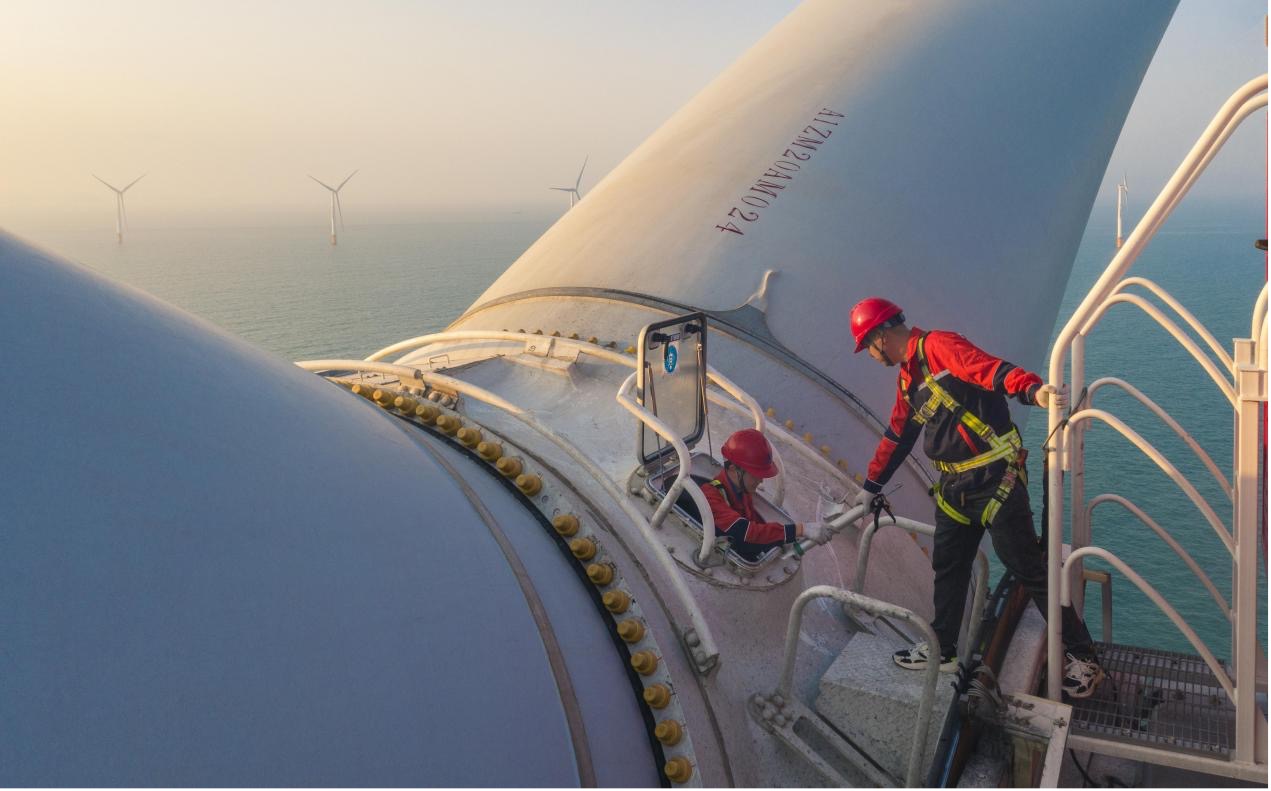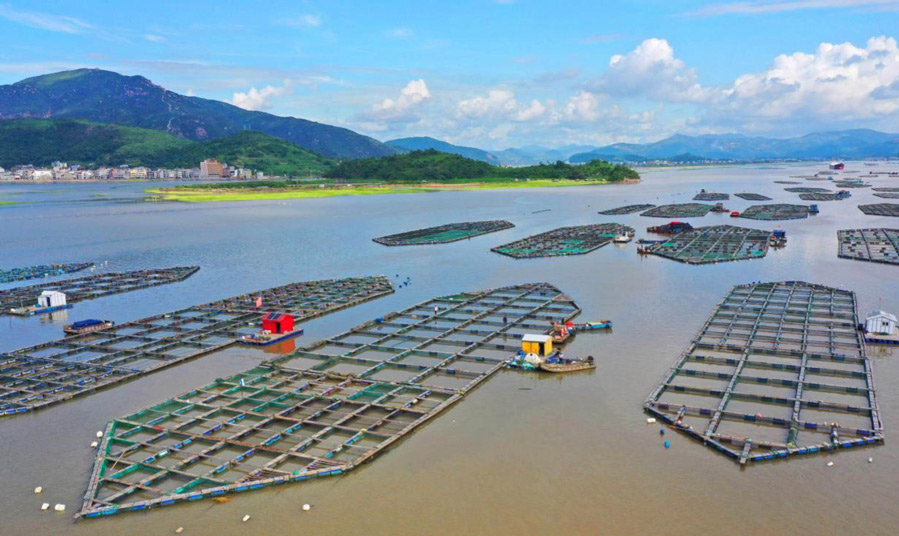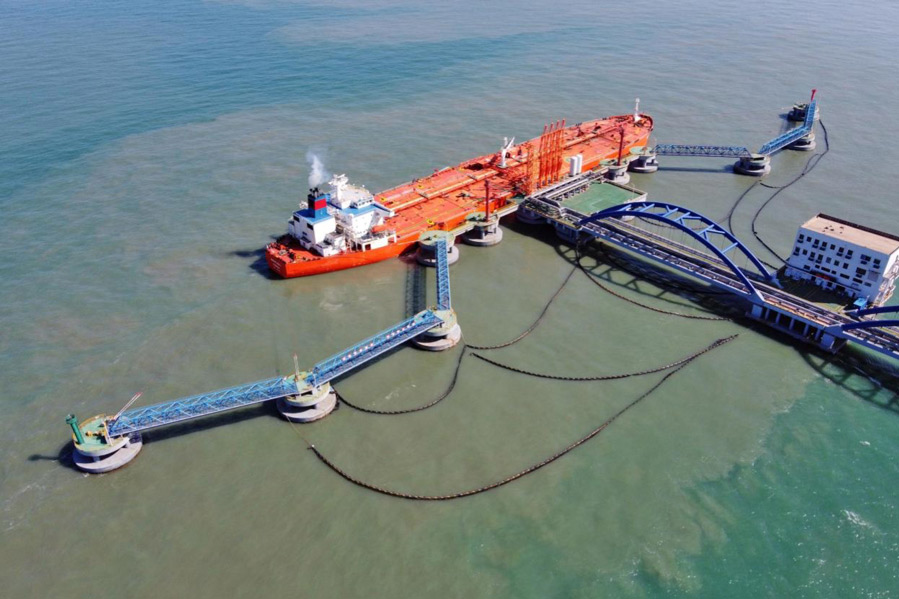China's gross ocean product hits 9 trillion yuan for first time

Technicians maintain a wind turbine at a wind farm in Zhuhai, south China's Guangdong province, April 12, 2021. (Photo by Qiu Xinsheng/People's Daily Online)
China's gross ocean product rose 8.3 percent to nearly 9.04 trillion yuan (about $1.42 trillion) in 2021, the first time the figure has crossed the 9-trillion-yuan mark, said a statistical communiqué recently released by the country's Ministry of Natural Resources.
According to the communiqué, the figure contributed 8 percent of the country's gross domestic product expansion.
The added value of the marine primary industry stood at 456.2 billion yuan, while those of the secondary and tertiary industries were 3.01 trillion and 5.56 trillion yuan, respectively. The three figures accounted for 5 percent, 33.4 percent and 61.6 percent of China's gross ocean product.
The marine economy accounted for 15% of total GDP in China's coastal regions, a 0.1 percentage point increase from the previous year.
The last year saw a gradual release of the market potential, and the marine foreign trade kept rising. The number of newly registered enterprises in key maritime sectors increased 5.7 percent year on year, while there was a 5.1-percent drop in the number of the deregistered.
In 2021, the total imports and exports via maritime transport were up by 22.4 percent from a year ago, and the country exported offshore wind turbines for the first time. Coastal ports handled a total of 4.19 billion tonnes of foreign trade cargos, up 4.6 percent year on year. Maritime transport also witnessed rapid growth, with added value in the sector increasing 10.3 percent from a year ago.
Last year, China constantly enhanced its sci-tech innovation capacity in the sphere of the marine economy, with new breakthroughs made in a number of key areas.
According to the statistical communiqué, the country has further improved its capability in the manufacturing of high-end offshore equipment. China's first 174,000-cubic meter floating liquefied natural gas storage and regasification unit was delivered, and the country's independently developed and manufactured typhoon-resistant floating offshore wind turbine was put into use in south China's Guangdong province, too.
Besides, China's first offshore wind power project that combines power generation and storage will be delivered soon, and its first independently developed subsea Xmas tree system completed sea trials in the Bohai Sea.
Emerging marine industries saw robust growth. In 2021, the added value of marine biomedicine increased by 18.7 percent year on year, while the figures for marine power and seawater exploitation were 30.5 percent and 16.4 percent, respectively. Such growth was obviously faster than that in major marine industries.
Traditional marine industries accelerated upgrading and transformation, and pilot programs of modern marine farming were advanced in an orderly manner. As of the end of 2021, the country has established 136 demonstration marine farms at national level.

Floating bamboo rafts are employed for oyster breeding in Dongmentou village, Wenling, east China's Zhejiang province, June 7, 2021. (Photo by Liu Zhenqing/People's Daily Online)
Besides, the marine shipbuilding companies have become greener. Green energy vessels accounted for 24.4 percent of the shipbuilding orders they received in the past year.
The supply of marine energy and marine products has been enhanced over the past years. Seawater desalination industry was expanded. Tianjin municipality, Hebei province and Shandong province have successively launched major engineering projects of seawater desalination to ensure fresh water supply in places with scarce water resources.
The production of marine oil and gas increased 6.2 percent and 6.9 percent year on year, respectively, and the development of clean energy maintained robust momentum. Last year, China connected 16.9 GW of offshore wind capacity to the state grid, 4.5 times of that from a year ago. It placed the country on the first spot in the world in terms of total installed offshore wind capacity.
Deep-sea aquaculture was further advanced. The largest smart net cage in Asia developed by China welcomed a harvest last year, and the “Deep Blue 1” fully-submersible deep-sea fish cage also harvested salmons for the first time.

An oil tanker docks at a terminal in Yantai, east China's Shandong province, Oct. 12, 2021. (Photo by Tang Ke/People's Daily Online)
In recent years, China has rolled out a number of marine policies that make clearer the blueprint for marine economy in the 14th Five-Year Plan period (2021-2025).
"The sound momentum for recovery and positive development of the marine economy remains unchanged in 2022, and so do the production factors that support high-quality development of the sector," said Cui Xiaojian, deputy director of the National Marine Data and Information Service.
So far, 11 coastal provinces and some of the coastal cities in China have issued relevant plans to spur the development of the marine economy, and China has also issued state-level documents to promote the development of relevant industries, such as an action plan on seawater desalination between 2021 and 2025 and a national development plan on the fishing industry during the 14th Five-Year Plan period.
China will further optimize the structure of the marine economy, maintain major indexes of the sector in a reasonable range and continue promoting high-quality development of the marine economy.
Photos
Related Stories
- Chinese premier stresses promoting consumption to stabilize economic fundamentals
- Americans' dim view of economy could bode ill for Democrats
- Chinese premier calls for stabilization of employment, prices to shore up economy
- 63 percent of Americans rate U.S. economy as bad: poll
- Economic Watch: China to leverage agile monetary policies to bolster real economy
Copyright © 2022 People's Daily Online. All Rights Reserved.










